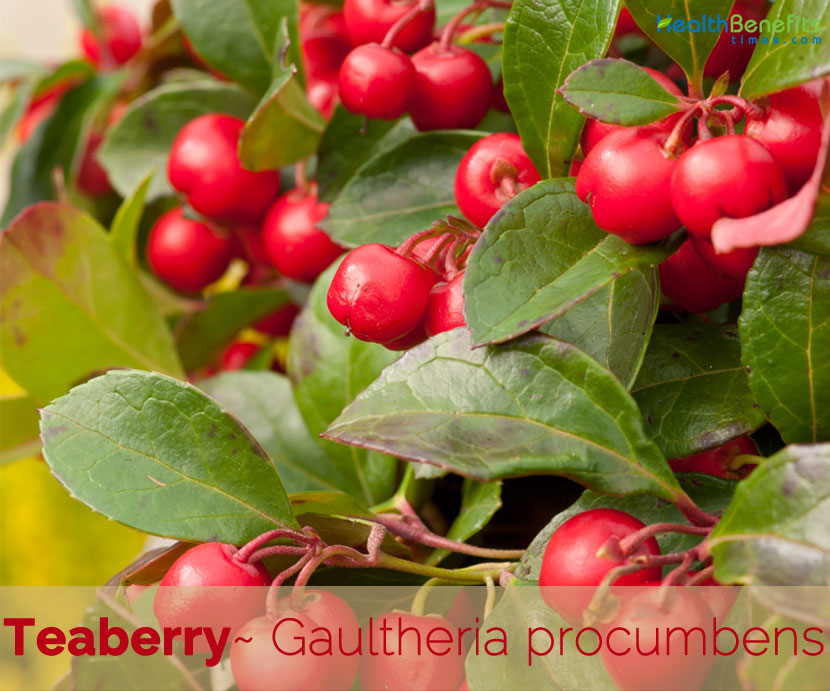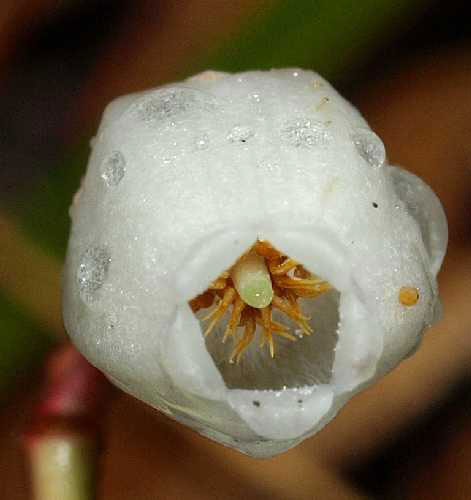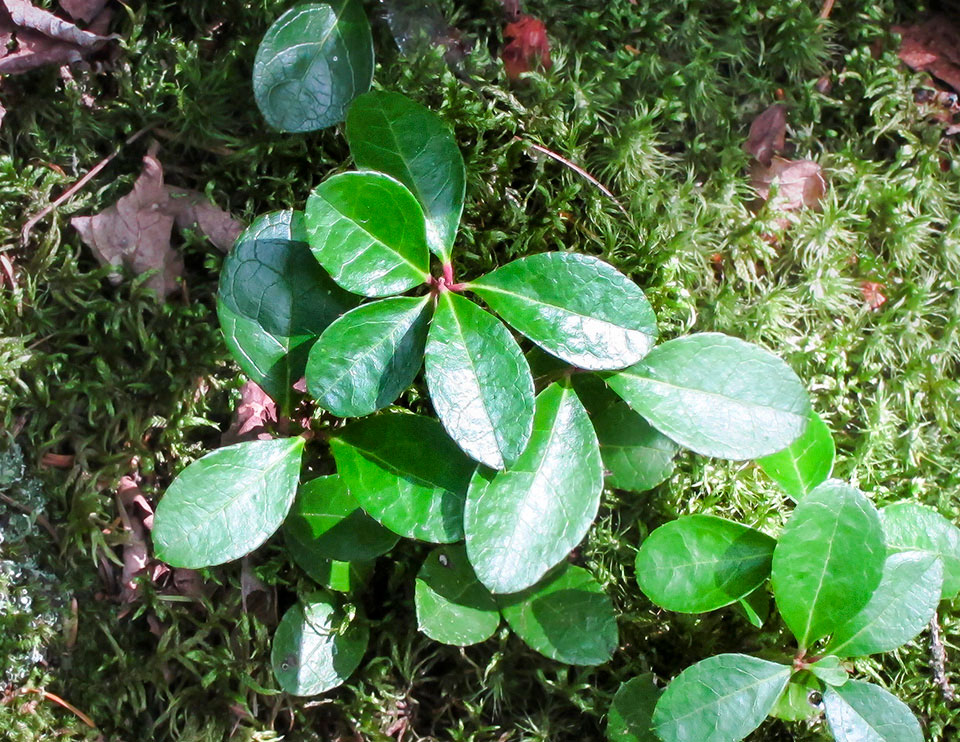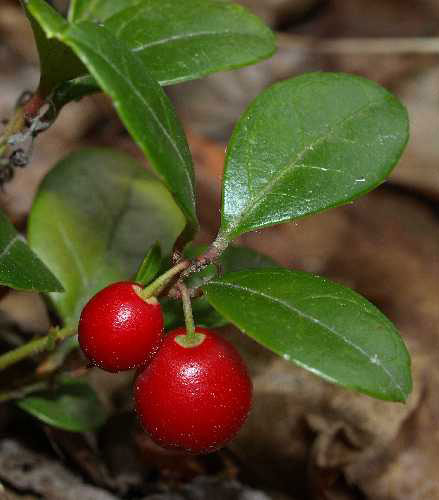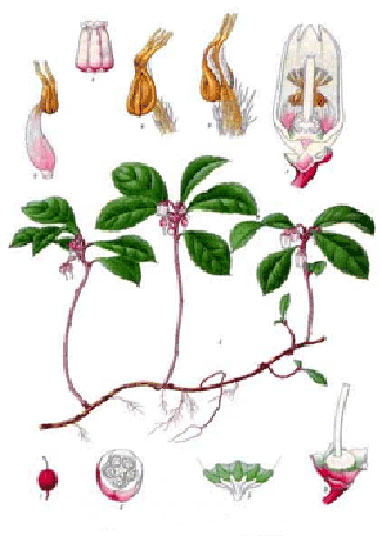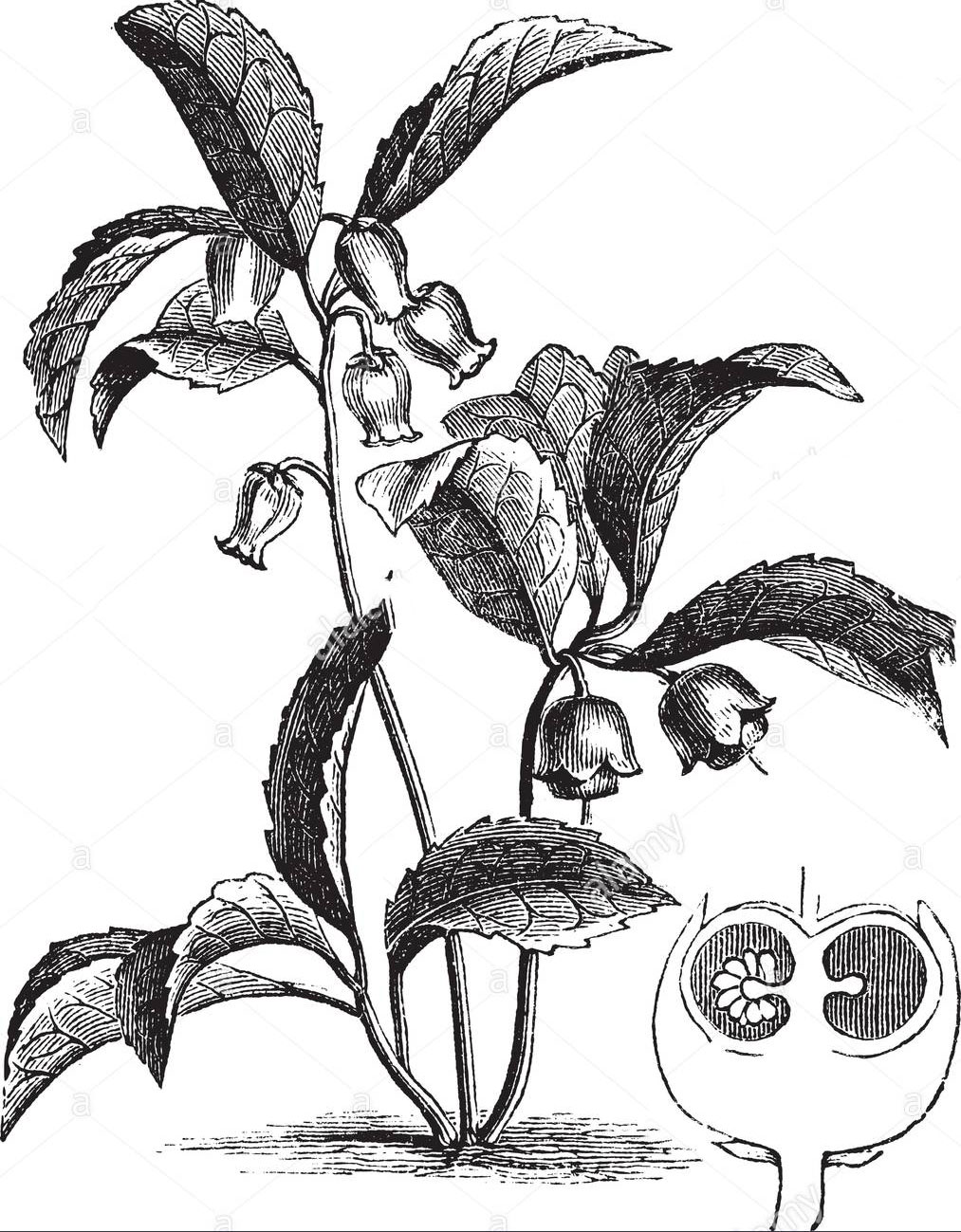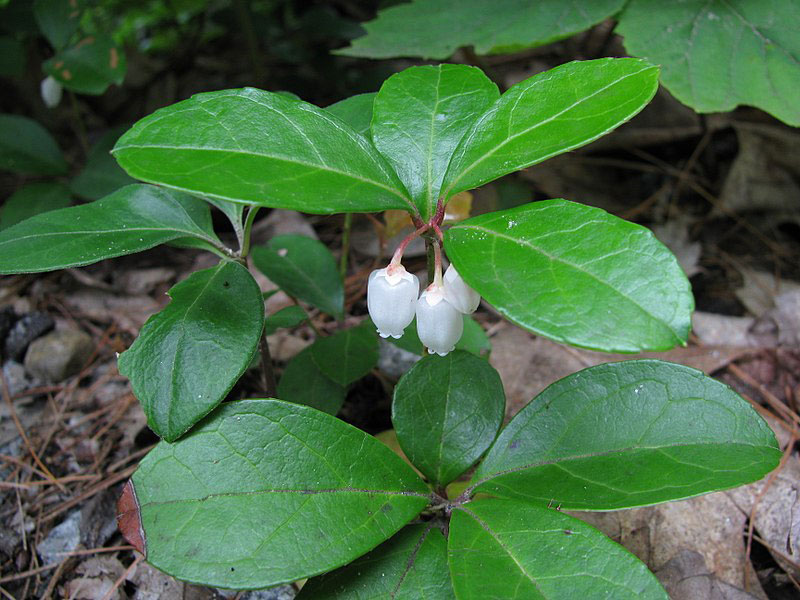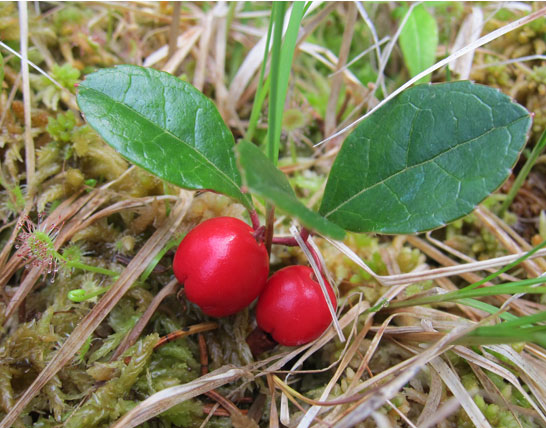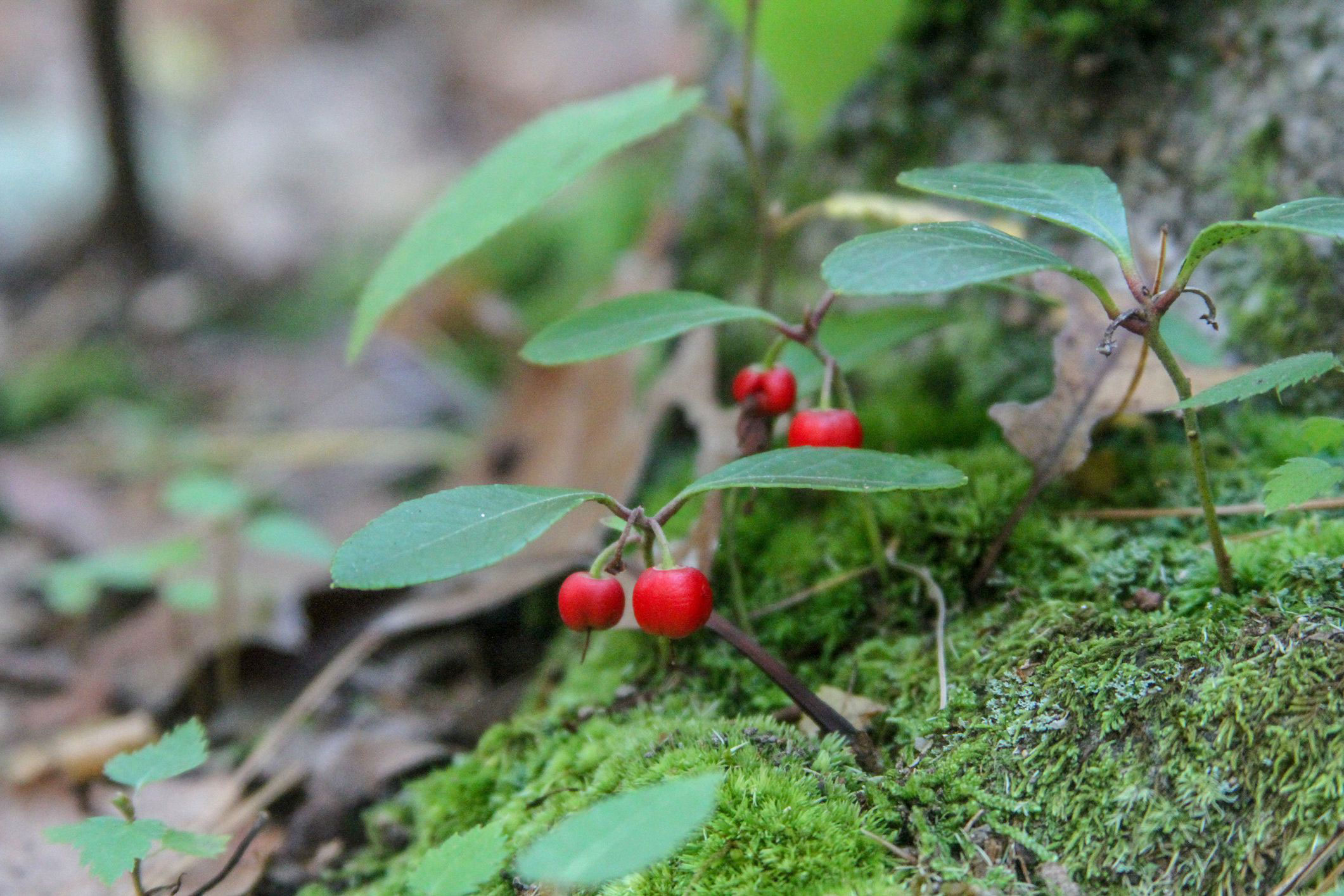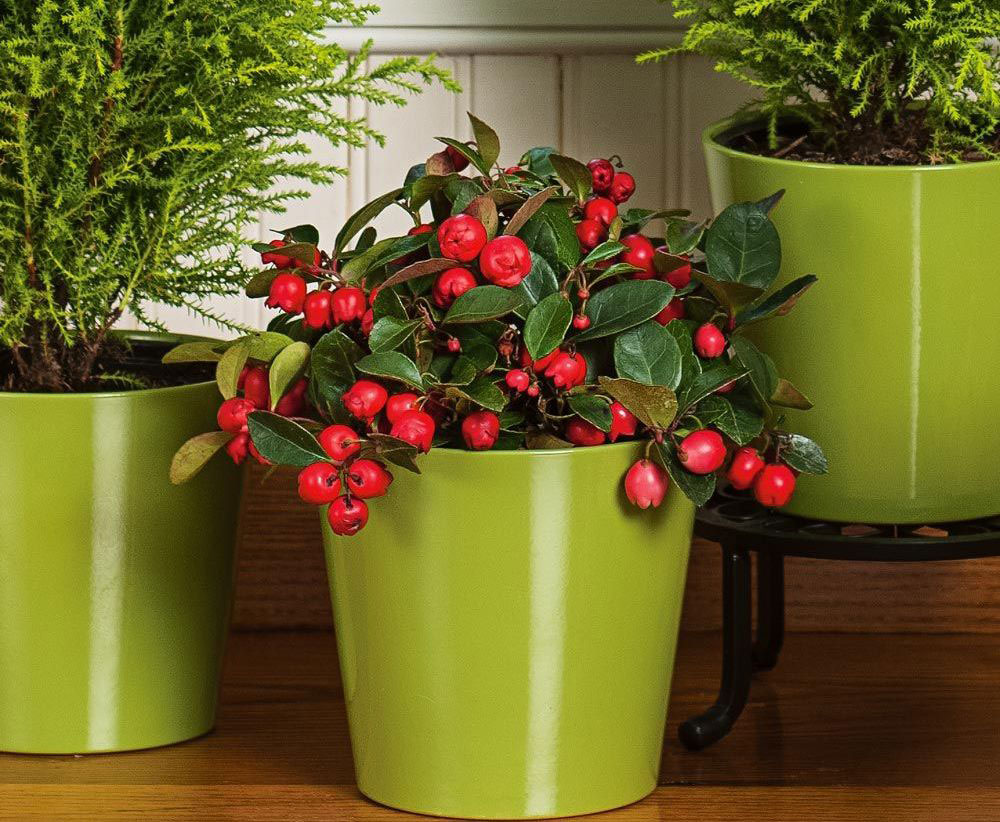The genus Gaultheria was named for Jean-François Gaultier, a naturalist and physician in Quebec in the mid-18th century. The species name procumbens apparently is derived from the Latin verb prōcumbō, which means to fall prostrate a reference to the prostrate habit of the plant. Different parts of the plants are used in different ways. Foliage was once used to make oil of wintergreen which has astringent, stimulant and diuretic properties. It has been a popular flavoring for chewing gum, candies and toothpaste. Dried leaves can be used to make an interesting tea, but this usage is no longer recommended. Leaves were once made into poultices for arthritic pain and sore muscles. Fruits may be eaten raw or added to pastries and salads.
Teaberry Facts
| Teaberry Quick Facts | |
|---|---|
| Name: | Teaberry |
| Scientific Name: | Gaultheria procumbens |
| Origin | Northeastern North America from Newfoundland west to southeastern Manitoba, and south to Alabama |
| Colors | Very light green when young maturing to bright red |
| Shapes | Berrylike capsule with a large fleshy calyx |
| Taste | Sweet, Astringent |
| Health benefits | Beneficial for rheumatism, sciatica, myalgia, sprains, neuralgia, catarrh, headache, Muscle Pain, Cold, Leucorrhea, Diarrhea, Colitis, sore throats and lower back pain |
| Name | Teaberry |
|---|---|
| Scientific Name | Gaultheria procumbens |
| Native | Northeastern North America from Newfoundland west to southeastern Manitoba, and south to Alabama |
| Common Names | American mountain tea, boxberry, Canada tea, canterberry, checkerberry, chickenberry, creeping wintergreen, deerberry, drunkards, gingerberry, ground berry, ground tea, grouseberry, hillberry, mountain tea, one-berry, procalm, red pollom, spice berry, squaw vine, star berry, spiceberry, spicy wintergreen, spring wintergreen, teaberry, wax cluster, youngsters, partridge berry, eastern teaberry, american wintergreen, chinks, ivory plum, American winterberry, box berry, deer berry, ground holly, woodsman’s tea, Shrublet, Alpine wintergreen |
| Name in Other Languages | Afrikaans: Tee-Berry Albanian: Caj-berry Amharic: Shayi-bērī (ሻይ-ቤሪ),yek’ura shayi (የቁራ ሻይ) Arabic: Altawatu alshshayi (التوت الشاي), eunb al’ard (عنب الأرض) Armenian: Tey-hataptugh (թեյ-հատապտուղ) Azerbaijani: Cay-giləmeyvə Bengali: Cā bēri (চা বেরি) Bulgarian: Chaĭ-Beri (чай-Бери) Burmese: Laathpaatrai berry see (လက်ဖက်ရည် berry သီး) Chinese: Fu wo bai zhu shu, Ping pu bai zhu shu, Ye cha bai zhu shu, Chá jiāngguǒ (茶浆果) Croatian: Caj bobica Czech: Cajové bobule, libavka poléhavá Danish: Bjergte, Nordamerikansk vintergrøn, Vintergrøn, te-bær, Nedliggende Bjergte Dutch: Bergthee, Kruipende patrijsbes, theebes English: Aromatic wintergreen, Box berry, Canada tea, Checkerberry, Checkerberry wintergreen, Creeping wintergreen, Deerberry, Eastern teaberry, Hillberry, Mountain tea, Partridgeberry, Redberry, Spice berry, Spicy wintergreen, Teaberry, Wintergreen, Eastern wintergreen, Spring wintergreen, spicy wintergreen checkerberry Esperanto: Teo-bero Estonian: Tee-marja Filipino: Tsaa-berry, Lamosalali Finnish: Tee täytteet French: Gaulthérie, Gaulthérie couchée, Petit thé des bois (Canada), Thé des bois, baies de thé, Petit thé, Pommes de terre, Thé rouge Georgian: Chai-k’enk’ra (ჩაი-კენკრა) German: Amerikanisches Wintergrün, Kanadischer thee, Nordamerikanische Wintergrün, Scheinbeere, Wintergrün, Wintergrün Pflanze, Wintergrünstrauch, Tee-Beere, Niedere Scheinbeere, niederliegende Rebhuhnbeere, niederliegende Scheinbeere, Teebeerenstrauch Greek: Tsái-moúro (τσάι-μούρο) Gujarati: Cā-bērī (ચા-બેરી) Hausa: Shayi-Berry Hebrew: ברי תה Hindi: Chaay-beree (चाय-बेरी) Hungarian: Tea-bogyó, Kúszó fajdbogyó Icelandic: Te-ber Indonesian: Teh-berry Irish: Caora tae Italian: Tea-berry Japanese: Tīberī (ティーベリー), U~intāgurīn (ウィンターグリーン) Javanese: Beri-teh Kannada: Ṭī-berri (ಟೀ-ಬೆರ್ರಿ) Kazakh: Say-jïdek (шай-жидек) Korean: Ti beli (티 베리) Kurdish: Cay-berry Lao: Mak mineu (ໝາກ ມີເນື້ອ) Latin: Baca tea Latvian: Tējas oga Lithuanian: Arbatos-uogos Macedonian: Caj-beri (чај-бери), zimzelen (зимзелен) Malagasy: Dite-Berry Malay: Teh-berry Malayalam: Tī-beṟi (ടീ-ബെറി) Maltese: Berry tat-te Marathi: Cahā-bōrāsārakhē bī asalēlē lahāna phaḷa-Cahā (चहा-बोरासारखे बी असलेले लहान फळ), bōrāsārakhē bī asalēlē lahāna phaḷa-Cahā-bōrāsārakhē bī asalēlē lahāna phaḷa Mongolian: Tsai-jims (цай-жимс) Nepali: Chiya-beree (चिया-बेरी) Norwegian: Te-bær Oriya: ଚା-ବେରୀ | Pashto: چای بیری Persian: چای-توت, انگورک Polish: Herbata-jagoda, Golteria rozesłana Portuguese: Gaultéria, baga de chá Punjabi: Cāha-bērī (ਚਾਹ-ਬੇਰੀ) Romanian: Ceai-Berry Russian: Gaul’teriia lezhachaia, chay-yagodnyye (чай-ягодные), Gaul’teriya lezhachaya (Гаультерия лежачая) Serbian: Caj-bobica (чај-бобица) Sindhi: چانھ جو ٻير Sinhala: Tē-berī (තේ-බෙරී) Slovenian: Caj-jagodičje Spanish: Gaulteria, Té del Canada, baya de té Sundanese: Berry-tea Swedish: Amerikanskt vaktelbär, Tuvvaktelbär, Vaktelbär, Vintergröna, te-bär Tajik: Choi-Byerri (чой-Берри) Tamil: Tēnīr-perri ()தேநீர்-பெர்ரி Telugu: Ṭī-berrī (టీ-బెర్రీ) Thai: Chā bexr̒ rī̀ (ชาเบอร์รี่) Turkish: Cay-dut Ukrainian: Chayno-yahidnyy (чайно-ягідний) Urdu: چائے بیری Uzbek: Choy berry Vietnamese: Trà-berry Welsh: Aeron te, gweunlwyn ymlusgol Zulu: Itiye-amajikijolo |
| Plant Growth Habit | Small indigenous shrubby, creeping, spreading, low-growing evergreen, rhizomatous shrub |
| Growing Climates | Sterile woods and clearings, beneath evergreen trees, sandy and barren plains, mountainous tracts, mesic forests, dry, acidic woodlands, coniferous woodlands, bogs and fens, road banks, old pastures, montane heath balds |
| Soil | Prefers a moist but not too wet humus rich soil. A peat and moisture loving species, it requires a lime-free soil |
| Plant Size | 4 to 8 inches (10-20 cm) tall |
| Root | Shallow rhizomes, from which clonal subshrubs develop |
| Twigs | Slender, green turning brown with age |
| Stem | Ascending semi-woody stems are sparingly branched. These stems are light green to bright red and more or less terete |
| Bark | Light brown |
| Leaf | Evergreen, elliptic to ovate, 2–5 cm (3⁄4–2 in) long and 1–2 cm (1⁄2–3⁄4 in) broad, with a distinct oil of wintergreen scent |
| Flowering season | July to August |
| Flower | About 1/3 inches (8 mm.) in length, consisting of a white bell-shaped corolla (sometimes tinted pink) with 5 short outwardly curled lobes, a white calyx with 5 ovate-oval lobes, 5 inserted stamens, and a pistil with a single stout style |
| Fruit Shape & Size | Small berry-like capsules that become mature during late summer or early autumn. Mature fruits are about ¼ to ⅓ inches or slightly more across, and globoid in shape |
| Fruit Color | Very light green when young maturing to bright red |
| Propagation | Seed, Semi-hardwood cuttings |
| Flavor/Aroma | Peculiar and aromatic |
| Taste | Sweet, Astringent |
| Plant Parts Used | Leaves, stem, fruit, essential oil, roots |
| Available Forms | Tea, fresh, dried or fermented |
| Season | October to December |
Plant Description
Teaberry is a small indigenous shrubby, creeping, spreading, low-growing evergreen, rhizomatous shrub that normally grows about 4 to 8 inches (10-20 cm) tall. The plant is found growing in sterile woods and clearings, beneath evergreen trees, sandy and barren plains, mountainous tracts, mesic forests, dry, acidic woodlands, coniferous woodlands, bogs and fens, road banks, old pastures and montane heath balds. The plant prefers a moist but not too wet humus rich soil. A peat and moisture loving species, it requires a lime-free soil. Once it is well established it succeeds in dry soils and tolerates considerable drought. Ascending semi-woody stems are sparingly branched. The root system has shallow rhizomes, from which clonal subshrubs develop. These stems are light green to bright red and more or less terete. They are sparsely to moderately cover with appressed white hairs. Twigs are slender, green turning brown with age.
Leaves
Alternate evergreen leaves occur along the stem. Leaves are ¾–2 inches (2–5 cm.) long and about one-third to one-half as much across. They are elliptic, ovate, obovate, or oval in shape. The margins of the leaves are sparsely serrated with bristly teeth. The upper leaf surface is medium to dark green, hairless, and shiny, while the lower leaf surface is light green, hairless to sparsely appressed-hairy, and dull. Leaf texture is somewhat stiff and leathery, while leaf venation is pinnate. Petioles of the leaves are light green to bright red and less than ¼ inches (6 mm.) long. They are sparsely to moderately cover with appressed white hairs. Foliage of this sub-shrub has a minty (or wintergreen) fragrance, especially when it is crushed. Either solitary or short racemes of 2-5 nodding flowers develop from the upper leaf axils.
Flower
Each flower is about 1/3 inches (8 mm.) in length, consisting of a white bell-shaped corolla (sometimes tinted pink) with 5 short outwardly curled lobes, a white calyx with 5 ovate-oval lobes, 5 inserted stamens, and a pistil with a single stout style. The calyx is much shorter than the corolla. At the base of each flower, there is a pair of tiny ovate to heart-shaped bracts. These bracts can be light green, white, or red, and they have membranous margins. The pedicels of the flowers are up to 1/3 inches (8 mm.) in length, light green to red, and more or less terete; they are sparsely to moderately covered with appressed white hairs. The blooming period occurs from early to mid-summer, lasting about 3 weeks. The flowers are reported to be fragrant.
Fruit
Afterwards, fertile flowers are replaced by small berry-like capsules that become mature during late summer or early autumn. Mature fruits are about ¼ to ⅓ inches or slightly more across, and globoid in shape. The berries are initially a very light green (in late August and early September), usually maturing to bright red by around October. They have a fleshy interior that is slightly sweet and minty (wintergreen) in flavor. Each berry has a distinctive notched pucker on its underside and contains numerous tiny seeds. The berries often persist throughout the winter (unless eaten by wildlife or passing humans) and are said to be larger and tastier in the spring than in autumn.
Berries are an excellent winter food for some wildlife such as pheasant, grouse, squirrels and deer. Foliage was once used to make oil of wintergreen which has astringent, stimulant and diuretic properties. Wintergreen has been a popular flavoring for chewing gum, candies and toothpaste. Dried leaves can be used to make an interesting tea (teaberry is a sometimes-used common name for this plant), but this usage is no longer recommended. Leaves were once made into poultices for arthritic pain and sore muscles. Fruits may be eaten raw or added to pastries and salads.
Traditional uses and benefits of Teaberry
- Checkerberry leaves were widely used by the native North American Indians in the treatment of aches and pains and to help breathing whilst hunting or carrying heavy loads.
- Leaves, and the oil, are analgesic, anti-inflammatory, aromatic, astringent, carminative, diuretic, emmenogogue, stimulant and tonic.
- An infusion of the leaves is used to relieve flatulence and colic.
- Plant in the form of the essential oil, is most useful when applied externally in the treatment of acute cases of rheumatism, sciatica, myalgia, sprains, neuralgia and catarrh.
- Oil is occasionally used in the treatment of cellulitis, a bacterial infection that causes the skin to become inflamed.
- It should not be recommended for patients who are hypersensitive to salicylates (aspirin).
- It strengthens and relaxes the uterine muscles. It is best for Menstrual Cramps.
- Wintergreen lotion helps to ease soreness after breastfeeding. The Wintergreen tea cures Headache, Muscle Pain and Cold.
- It relieves Pelvic Congestion. It alleviates the mucous discharge of Leucorrhea.
- It acts as an aid in Childbirth.
- It decreases catarrh and excess mucus.
- It is beneficial in the treatment of diarrhea and colitis.
- It has a soothing effect on the nervous system.
- It eases nervous exhaustion and irritability.
- It is effective in case of Edema.
- American Indians reportedly used wintergreen for treating back pain, rheumatism, fever, headaches, and sore throats.
- Plant and its oil have been used in traditional medicine as a pain reliever, for indigestion, and to protect the skin and reduce bleeding from minor cuts.
- Tea has been used to relieve cold symptoms and muscle aches.
- Its oil has been used on the skin in preparations for the treatment of muscular and rheumatic pain.
- Teaberry tea has been frequently used to help with headaches.
- Tea is also taken to help ease joint pains and inflammations.
- It is also used for digestion problems including stomachache and gas (flatulence); lung conditions including asthma and pleurisy; pain and swelling (inflammation); fever; and kidney problems.
- Some people use small doses of its oil to increase stomach juices and improve digestion.
- Its leaf is occasionally applied directly to the skin as a wash for achy joints (rheumatism), sore muscles, and lower back pain.
- Teaberry oil is applied to the skin as a “counterirritant” to relieve muscle pain.
- Teaberry oil is also used to kill germs on the skin.
- Essential oil is used to heal backaches, tendinitis, arthritis, and rheumatism or muscle contractions such as low back pain.
- It has also been used to treat bladder inflammation and diseases of the urinary tract.
- It has also been used to relieve children’s headaches.
- Leaves have also been used for headaches and other pains, and as a gargle for a sore throat and mouth.
Ayurvedic Health Benefits of Teaberry
- Sore Throat: Boil 3 to 4 leaves of Wintergreen in a glass of water for 10 minutes on low flame. Strain. Have half a cup twice a day.
- Leucorrhoea: Boil some Wintergreen leaves in a cup of water. Let it cool. Filter and use as a douche for leucorrhoea.
- Skin Diseases: Crush some fresh Wintergreen leaves. Apply on the affected part. Bandage and leave it overnight. (Note: Do it till the problem persists.)
- Inflammation: Grind fresh leaves of Wintergreen. Place it over the inflamed area. Leave it for at least 2 hours. Wash it with normal water.
- Plantar Fasciitis: Tincture the whole plant of Arnica. Take 5 drops a day in water. Take for 7 days. OR: Buy tincture of Arnica over the counter. Take 5 drops in water every day, for 7 days.
- Emphysema: Put 3 tablespoon each of Wintergreen and Eucalyptus in One jug of boiled water. Have steam bath.
Culinary Uses
- Fruit can be consumed raw or cooked.
- Fruits can also be used in pies, or made into jams etc.
- Young leaves can be consumed raw.
- It is a pleasant wayside nibble if used when very young.
- Very agreeable tea is made from the fresh leaves.
- Stronger tea can be made by first fermenting the bright red leaves.
- ‘Oil of wintergreen can be distilled from this plant.
- It is used to flavor beer, sweets, chewing gum etc.
Other Facts
- An essential oil is obtained from the leaves by steam distillation.
- Essential oil is used as a food flavoring, medicinally (the original source of Wintergreen oil used as a liniment for aching muscles) and in perfumery and toothpastes.
- In large doses it can be toxic.
- Forming a dense tuft-like carpet, it roots as it spreads and should be spaced about 45cm apart each way.
- Dynamic accumulator gathering minerals or nutrients from the soil and storing them in a more bioavailable form – used as fertilizer or to improve mulch.
- Teaberry extract can be used to flavor tea, candy, medicine and chewing gum.
- Teaberry is also a flavor of ice cream in regions where the plant grows.
Precautions
- The pure distilled essential oil is toxic in large doses.
- If used orally it may worsen stomach ulcers.
- It should not be used by people who are allergic to aspirin.
- Avoid use if you are less than 12.
- Topical use can cause contact dermatitis.
- Since essential oil is toxic in excess, causing liver and kidney damage.
- It may cause Nausea or diarrhea.
- Do not use with blood thinning medicines.
- Do not use essential oil orally.
- Avoid use 2 weeks after pregnancy.
- Wintergreen may cause allergic reactions.
- Topical administration may cause redness and irritation.
References:
https://www.itis.gov/servlet/SingleRpt/SingleRpt?search_topic=TSN&search_value=23657#null
https://pfaf.org/user/plant.aspx?LatinName=Gaultheria+procumbens
http://www.missouribotanicalgarden.org/PlantFinder/PlantFinderDetails.aspx?kempercode=b718
https://www.botanical.com/botanical/mgmh/w/winter24.html
https://plants.usda.gov/core/profile?symbol=GAPR2
https://www.fs.fed.us/database/feis/plants/shrub/gaupro/all.html
https://en.wikipedia.org/wiki/Gaultheria_procumbens
https://gd.eppo.int/taxon/GAHPR
http://www.theplantlist.org/tpl1.1/record/kew-2817983
https://www.drugs.com/npc/wintergreen.html
https://wildadirondacks.org/adirondack-wildflowers-wintergreen-gaultheria-procumbens.html
https://www.illinoiswildflowers.info/woodland/plants/wintergreen.html
https://www.cabi.org/isc/datasheet/24760


